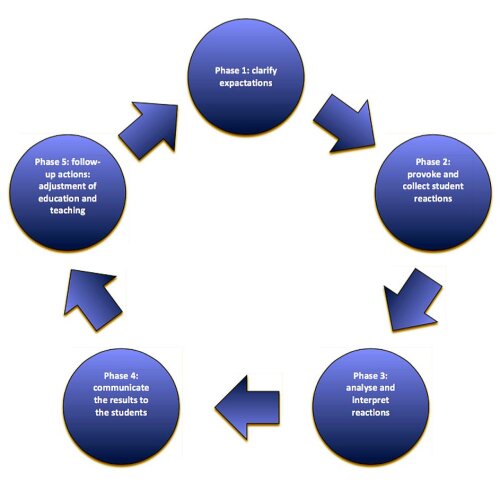Teacher Evaluation
Description
Evaluating the teacher implies that students can evaluate the teacher's classes and style of teaching. For this the teacher prepares an evaluation form. The questions in the evaluation can cover the content of the lessons, teaching style and the contact with the students.
How it works
- Make an evaluation sheet for each student.
- Decide if your students are to submit their forms anonymously or not.
- Allow plenty of time to fill in the evaluation form during the lesson.
- Provide open-ended questions or ask for written feedback if students give you a score.
- Give an example of the critical, constructive feedback you expect from them.
Tips
- Make sure that there is a safe, calm classroom atmosphere: stay away from the students when they are filling in the form, have a student collect the forms.
- There are plenty of methods for teacher evaluation by students. You can find inspiration here.
Examples
Formative Assessment as a Cyclical Process
Description
According to Gullikers and Baartman (2017) formative assessment fits within a cyclical process of five key phases.

The Dutch national centre of expertise on curriculum development (SLO) developed a self-assessment instrument (in Dutch) to find out how teachers score on these phases and what their strengths and weaknesses are.
Check out their methods (in Dutch) to engage in dialogue with colleagues and inspire them.
From Summative to Formative Assessment
Description
Obviously, students and teachers will have to get used to formative assessment, whereby not everything is evaluated with a mark. Below are various techniques that can be used as intermediate steps to move from summative to formative assessment or to combine both.
How it works
Integrating formative assessment with summative homework
- Two deadlines
- Deadline 1: Students submit their homework and get feedback. They are scored according to the quality of their work. Students can earn part of the total score with this. For example: 5 out of 20.
- Deadline 2: Students subsequently improve their homework based on the feedback they have received and submit the assignment a second time. They can now earn the majority of the points. For example: 15 out of 20.
- Correct your mistake yourself
- Highlight students' mistakes, but do not correct them. Use codes, e.g.: G for grammatical errors and S for spelling mistakes. Students have to correct the errors in their assignment themselves and submit it again afterwards. You can consider providing extra support by means of an instruction video. When you try out this method for the first time, you can award a bonus point, when students have corrected all their errors properly.
- Mark does not count
- Students get two alternative homework assignments and can decide for themselves which assignment counts and will be scored, and which one does not.
Integrating formative assessment with summative tests
- Peer feedback after a test
- After handing out the marked test, students are divided in groups based on the components of the test: the students are assigned to the group of the component for which they scored best.
- The members of each group have to become experts in their allocated component. They get ten minutes, after which each group splits up to visit the other groups to answer questions.
- This process repeats itself until all test components have been covered.
- Revision exercise: make a revision exercises for a particular part of a chapter or a topic
- If students pass, this part will not be covered in a major test.
- If students do not pass, the revision exercise does not count. They receive feedback on the mistakes they made and retake this part at a major test.
- Self-reflection on a practice test
- Use a summative test from last year as a formative assessment tool.
- Students take the test without being scored and get an answer key so they can check the test themselves.
- Students fill in a self-evaluation form, on which they indicate which topics they have and have not mastered. They write down two actions they are going to take to make sure that they master the topics better.
- Peer feedback on a practice test
- Students take a practice test.
- Hand the test back to each student without having corrected it.
- Let them formulate an 'ideal answer' in groups of 3 or 4 students.
- Have a class discussion about the answers. Ask your students to assess their own answer.
- Self-reflection before or after an assignment